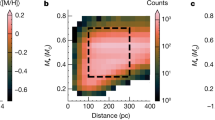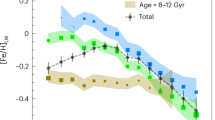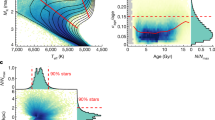Abstract
The evolution of galaxies throughout the last 12 Gyr of cosmic time has followed a single, universal relation that connects star-formation rates (SFRs), stellar masses (M⋆) and chemical abundances. Deviation from this fundamental scaling relation would imply a drastic change in the processes that regulate galaxy evolution. Observations have suggested the possibility that this relation may be broken in the very early Universe. However, until recently, chemical abundances of galaxies could be measured reliably only as far back as redshift z = 3.3. With the James Webb Space Telescope, we can now characterize the SFR, M⋆ and chemical abundances of galaxies during the first few hundred million years after the Big Bang, at redshifts z = 7–10. We show that galaxies at this epoch follow unique SFR–M⋆–main-sequence and mass–metallicity scaling relations, but their chemical abundance is one-fourth of that expected from the fundamental–metallicity relation of later galaxies. These findings suggest that galaxies at this time are still intimately connected with the intergalactic medium and subject to continuous infall of pristine gas, which effectively dilutes their metal abundances.
This is a preview of subscription content, access via your institution
Access options
Access Nature and 54 other Nature Portfolio journals
Get Nature+, our best-value online-access subscription
$29.99 / 30 days
cancel any time
Subscribe to this journal
Receive 12 digital issues and online access to articles
$119.00 per year
only $9.92 per issue
Buy this article
- Purchase on Springer Link
- Instant access to full article PDF
Prices may be subject to local taxes which are calculated during checkout




Similar content being viewed by others
Data availability
The JWST imaging and spectroscopic data are publicly available on the JWST MAST archive at https://mast.stsci.edu. The data has been processed using public software codes grizli v.1.8.3 (ref. 32) and msaexp v.0.6.7 (refs. 33,60). The reduced data are available from the corresponding author upon reasonable request.
References
Dayal, P. & Ferrara, A. Early galaxy formation and its large-scale effects. Phys. Rep. 780, 1–64 (2018).
Maiolino, R. & Mannucci, F. De re metallica: the cosmic chemical evolution of galaxies. Astron. Astrophys. Rev. 27, 3 (2019).
Matthee, J. et al. EIGER. II. First spectroscopic characterization of the young stars and ionized gas associated with strong Hβ and [O III] line-emission in galaxies at z = 5–7 with JWST. Astrophys. J. 950, 67 (2023).
Planck Collaboration. et al. Planck 2018 results. VI. Cosmological parameters. Astron. Astrophys. 641, A6 (2020).
Carnall, A. C., McLure, R. J., Dunlop, J. S. & Davé, R. Inferring the star formation histories of massive quiescent galaxies with BAGPIPES: evidence for multiple quenching mechanisms. Mon. Not. R. Astron. Soc. 480, 4379–4401 (2018).
Whitler, L. et al. Star formation histories of UV-luminous galaxies at z ≈ 6.8: implications for stellar mass assembly at early cosmic times. Mon. Not. R. Astron. Soc. 519, 5859–5881 (2023).
Giménez-Arteaga, C. et al. Spatially resolved properties of galaxies at 5 < z < 9 in the SMACS 0723 JWST ERO field. Astrophys. J. 948, 126 (2023).
Pacifici, C. et al. The art of measuring physical parameters in galaxies: a critical assessment of spectral energy distribution fitting techniques. Astrophys. J. 944, 141 (2023).
Kennicutt, J. & Robert, C. Star formation in galaxies along the Hubble sequence. Annu. Rev. Astron. Astr. 36, 189–232 (1998).
Kroupa, P. On the variation of the initial mass function. Mon. Not. R. Astron. Soc. 322, 231–246 (2001).
Osterbrock, D. E. & Ferland, G. J. Astrophysics of gaseous nebulae and active galactic nuclei (University Science Books, 2006).
Thorne, J. E. et al. Deep extragalactic visible legacy survey (DEVILS): SED fitting in the D10-COSMOS field and the evolution of the stellar mass function and SFR-M⋆ relation. Mon. Not. R. Astron. Soc. 505, 540–567 (2021).
Hutter, A. et al. Astraeus I: the interplay between galaxy formation and reionization. Mon. Not. R. Astron. Soc. 503, 3698–3723 (2021).
D’Silva, J. C. J., Lagos, C. D. P., Davies, L. J. M., Lovell, C. C. & Vijayan, A. P. Unveiling the main sequence of galaxies at z ≥ 5 with the JWST: predictions from simulations. Mon. Not. R. Astron. Soc. 518, 456–476 (2023).
Ceverino, D., Klessen, R. S. & Glover, S. C. O. FirstLight - II. Star formation rates of primeval galaxies from z=5-15. Mon. Not. R. Astron. Soc. 480, 4842–4850 (2018).
Nelson, D. et al. First results from the TNG50 simulation: galactic outflows driven by supernovae and black hole feedback. Mon. Not. R. Astron. Soc. 490, 3234–3261 (2019).
Sanders, R. L. et al. Direct T_e-based metallicities of z=2-9 galaxies with JWST/NIRSpec: empirical metallicity calibrations applicable from reionization to cosmic noon. Preprint at https://doi.org/10.48550/arXiv.2303.08149 (2023).
Nakajima, K. et al. EMPRESS. v. metallicity diagnostics of galaxies over 12 + log(O/H) ≈ 6.9-8.9 established by a local galaxy census: preparing for JWST spectroscopy. Astrophys. J. Suppl. S. 262, 3 (2022).
Curti, M., Mannucci, F., Cresci, G. & Maiolino, R. The mass-metallicity and the fundamental metallicity relation revisited on a fully Te-based abundance scale for galaxies. Mon. Not. R. Astron. Soc. 491, 944–964 (2020).
Ucci, G. et al. Astraeus V: the emergence and evolution of metallicity scaling relations during the epoch of reionization. Mon. Not. R. Astron. Soc. 518, 3557–3575 (2023).
Langan, I., Ceverino, D. & Finlator, K. Weak evolution of the mass-metallicity relation at cosmic dawn in the FirstLight simulations. Mon. Not. R. Astron. Soc. 494, 1988–1993 (2020).
Lovell, C. C. et al. First light and reionization epoch simulations (FLARES) - I. environmental dependence of high-redshift galaxy evolution. Mon. Not. R. Astron. Soc. 500, 2127–2145 (2021).
Mannucci, F., Cresci, G., Maiolino, R., Marconi, A. & Gnerucci, A. A fundamental relation between mass, star formation rate and metallicity in local and high-redshift galaxies. Mon. Not. R. Astron. Soc. 408, 2115–2127 (2010).
Sanders, R. L. et al. The MOSDEF survey: the evolution of the mass-metallicity relation from z = 0 to z ~ 3.3. Astrophys. J. 914, 19 (2021).
Troncoso, P. et al. Metallicity evolution, metallicity gradients, and gas fractions at z ~3.4. Astron. Astrophys. 563, A58 (2014).
Onodera, M. et al. ISM excitation and metallicity of star-forming galaxies at z ≈ 3.3 from near-IR spectroscopy. Astrophys. J. 822, 42 (2016).
Curti, M. et al. The chemical enrichment in the early universe as probed by JWST via direct metallicity measurements at z ~ 8. Mon. Not. R. Astron. Soc. 518, 425–438 (2023).
Lagos, Cd. P. et al. Shark: introducing an open source, free, and flexible semi-analytic model of galaxy formation. Mon. Not. R. Astron. Soc. 481, 3573–3603 (2018).
Heintz, K. E. et al. The ALMA REBELS survey: the cosmic H I gas mass density in galaxies at z ≈ 7. Astrophys. J. Lett. 934, L27 (2022).
Madau, P. & Dickinson, M. Cosmic star-formation history. Annu. Rev. Astron. Astr. 52, 415–486 (2014).
Astropy Collaboration. et al. Astropy: a community Python package for astronomy. Astron. Astrophys. 558, A33 (2013).
Brammer, G. Grizli: Grism redshift and line analysis software. Astrophysics Source Code Library, record ascl:1905.001 (2019).
Brammer, G. msaexp: NIRSpec analysis tools. GitHub https://github.com/gbrammer/msaexp (2022).
Horne, K. An optimal extraction algorithm for CCD spectroscopy. Publ. Astron. Soc. Pac. 98, 609–617 (1986).
Jakobsen, P. et al. The Near-Infrared Spectrograph (NIRSpec) on the James Webb Space Telescope. I. Overview of the instrument and its capabilities. Astron. Astrophys. 661, A80 (2022).
Zitrin, A. et al. Hubble Space Telescope combined strong and weak lensing analysis of the CLASH sample: mass and magnification models and systematic uncertainties. Astrophys. J. 801, 44 (2015).
Williams, H. et al. A magnified compact galaxy at redshift 9.51 with strong nebular emission lines. Science 380, 416–420 (2023).
Endsley, R. et al. A JWST/NIRCam study of key contributors to reionization: the star-forming and ionizing properties of UV-faint z ~ 7 – 8 galaxies. Mon. Not. R. Astron. Soc. 524, 2312–2330 (2022).
Bruzual, G. & Charlot, S. Stellar population synthesis at the resolution of 2003. Mon. Not. R. Astron. Soc. 344, 1000–1028 (2003).
Ferland, G. J. et al. The 2017 release Cloudy. Rev. Mex. Astron. Astr. 53, 385–438 (2017).
Sugahara, Y. et al. Bridging optical and far-infrared emission-line diagrams of galaxies from local to the epoch of reionization: characteristic high [O III] 88 μm/SFR at z > 6. Astrophys. J. 935, 119 (2022).
Salim, S., Boquien, M. & Lee, J. C. Dust attenuation curves in the local universe: demographics and new laws for star-forming galaxies and high-redshift analogs. Astrophys. J. 859, 11 (2018).
Iyer, K. G. et al. Nonparametric star formation history reconstruction with gaussian processes. I. Counting major episodes of star formation. Astrophys. J. 879, 116 (2019).
Leja, J., Carnall, A. C., Johnson, B. D., Conroy, C. & Speagle, J. S. How to measure galaxy star formation histories. II. Nonparametric models. Astrophys. J. 876, 3 (2019).
Tacchella, S. et al. JWST NIRCam + NIRSpec: interstellar medium and stellar populations of young galaxies with rising star formation and evolving gas reservoirs. Mon. Not. R. Astron. Soc. 522, 6236–6249 (2023).
Carnall, A. C. et al. A first look at the SMACS0723 JWST ERO: spectroscopic redshifts, stellar masses, and star-formation histories. Mon. Not. R. Astron. Soc. 518, L45–L50 (2023).
Calzetti, D. et al. The dust content and opacity of actively star-forming galaxies. Astrophys. J. 533, 682–695 (2000).
Ma, X. et al. The difficulty of getting high escape fractions of ionizing photons from high-redshift galaxies: a view from the FIRE cosmological simulations. Mon. Not. R. Astron. Soc. 453, 960–975 (2015).
Izotov, Y. I., Stasińska, G., Meynet, G., Guseva, N. G. & Thuan, T. X. The chemical composition of metal-poor emission-line galaxies in the Data Release 3 of the Sloan Digital Sky Survey. Astron. Astrophys. 448, 955–970 (2006).
Nakajima, K. et al. JWST census for the mass-metallicity star-formation relations at z=4-10 with self-consistent flux calibration and the proper metallicity calibrators. Preprint at https://doi.org/10.48550/arXiv.2301.12825 (2023).
Pillepich, A. et al. First results from the TNG50 simulation: the evolution of stellar and gaseous discs across cosmic time. Mon. Not. R. Astron. Soc. 490, 3196–3233 (2019).
Vijayan, A. P. et al. First light and reionization epoch simulations (FLARES) - II: the photometric properties of high-redshift galaxies. Mon. Not. R. Astron. Soc. 501, 3289–3308 (2021).
Wilkins, S. M. et al. First light and reionisation epoch simulations (FLARES) VII: the star formation and metal enrichment histories of galaxies in the early universe. Mon. Not. R. Astron. Soc. 518, 3935–3948 (2022).
Kobayashi, C., Karakas, A. I. & Lugaro, M. The origin of elements from carbon to uranium. Astrophys. J. 900, 179 (2020).
Asplund, M., Grevesse, N., Sauval, A. J. & Scott, P. The chemical composition of the sun. Annu. Rev. Astron. Astr. 47, 481–522 (2009).
Chabrier, G. Galactic stellar and substellar initial mass function. Publ. Astron. Soc. Pac. 115, 763–795 (2003).
Shapley, A. E. et al. JWST/NIRSpec Balmer-line measurements of star formation and dust attenuation at z ~ 3-6. Preprint at https://doi.org/10.48550/arXiv.2301.03241 (2023).
Curti, M. et al. JADES: insights on the low-mass end of the mass–metallicity–star-formation rate relation at 3 < z < 10 from deep JWST/NIRSpec spectroscopy. Preprint at https://doi.org/10.48550/arXiv.2304.08516 (2023).
Heintz, K. E. et al. The gas and stellar content of a metal-poor galaxy at z = 8.496 as revealed by JWST and ALMA. Astrophys. J. Lett. 944, L30 (2023).
Brammer, G. msaexp: NIRSpec analysis tools. Zenodo (2022); https://zenodo.org/record/8314675
Acknowledgements
We thank D. Ceverino for his insight and suggestions on interpreting the FirstLight simulation output. We further acknowledge the GLASS, CEERS and UNCOVER collaborations; we are grateful they made their early data publicly available. K.E.H. acknowledges support from the Carlsberg Foundation Reintegration Fellowship Grant CF21-0103. C.A.M. and A.H. acknowledge support by the VILLUM FONDEN under grant no. 37459. The Cosmic Dawn Center (DAWN) is funded by the Danish National Research Foundation under grant no. 140. This work is based on observations made with the NASA/ESA/CSA James Webb Space Telescope. The data were obtained from the Mikulski Archive for Space Telescopes at the Space Telescope Science Institute, which is operated by the Association of Universities for Research in Astronomy, Inc., under NASA contract NAS 5-03127 for JWST.
Author information
Authors and Affiliations
Contributions
K.E.H. wrote the manuscript and led the analysis. G.B.B. reduced and extracted the photometric and spectroscopic data. C.G.-A. and V.B.S. performed the SED modelling. All authors contributed to the manuscript and aided in the analyses and interpretations.
Corresponding author
Ethics declarations
Competing interests
The authors declare no competing interests.
Peer review
Peer review information
Nature Astronomy thanks the anonymous reviewers for their contribution to the peer review of this work.
Additional information
Publisher’s note Springer Nature remains neutral with regard to jurisdictional claims in published maps and institutional affiliations.
Supplementary information
Supplementary Information
Supplementary Figs. 1–6 and Supplementary Table 1.
Rights and permissions
Springer Nature or its licensor (e.g. a society or other partner) holds exclusive rights to this article under a publishing agreement with the author(s) or other rightsholder(s); author self-archiving of the accepted manuscript version of this article is solely governed by the terms of such publishing agreement and applicable law.
About this article
Cite this article
Heintz, K.E., Brammer, G.B., Giménez-Arteaga, C. et al. Dilution of chemical enrichment in galaxies 600 Myr after the Big Bang. Nat Astron 7, 1517–1524 (2023). https://doi.org/10.1038/s41550-023-02078-7
Received:
Accepted:
Published:
Issue Date:
DOI: https://doi.org/10.1038/s41550-023-02078-7



